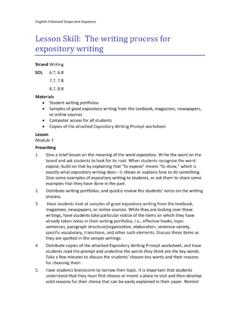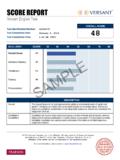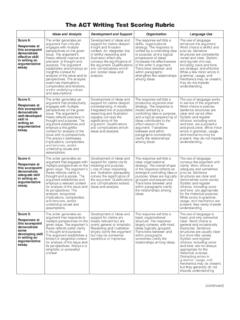Transcription of M-DCPS ESOL Strategies Matrix PartA
1 APPENDIX B. ESOL Strategies Matrix . Category Alpha Strategies /Resources Numeric ID. A1 LEA (Language Experience Approach). A2 Modeling A3 Teacher Lead Groups A. LISTENING A4 Total Physical Response (TPR). A5 Use Illustrations/Diagrams A6 Use Simple, Direct Language A7 Use Substitution, Expansion, Paraphrase, and Repetition A1. LEA (LANGUAGE EXPERIENCE APPROACH). The goal of the Language Experience Approach (LEA) is to have students produce language in response to first-hand, multi-sensorial LEA uses the students' ideas and their language to develop reading and writing skills. Steps for using the Language Experience Approach in the classroom: 1.
2 Providing the Experience/Motivation An experience story is based on an experience the teacher and students share. 2. Facilitation Language Production Immediately following an experience, students need to interact with each other to discuss the experience and what it meant to them. 3. Creating a Personal View Representation The teacher has the student draw or paint a picture about something interesting about the activity. 4. Retelling Events/Reactions A volunteer is selected to share his or her picture with the group. 5. Writing Student's Statements The teacher asks each student a question and records his/her answer, writing on the chalkboard exactly what the student says, using large manuscript letters.
3 After writing each statement, the teacher reads it back to the group for confirmation. When four or five statements are on the board, the students decide their sequential ordering. The statements are then numbered and transferred to a sentence strip, and the students correctly arrange the strips on a chart holder. 6. Reading After the chart or individual statements have been completed, students read their statements to each other and to the teacher. 7. Writing As students develop writing skills, they copy the story into their notebooks or on lined paper. 8. Follow Up with Activities The story may be reread on several subsequent days either by the teacher, the students, or both.
4 Students can also save the story with other language experience class stories to form their own class book for later reading. A2. MODELING. The teacher demonstrates to the learner how to do a task, with the expectation that the learner can copy the model. Modeling often involves thinking aloud or talking about how to work through a task. 1. APPENDIX B. A3. TEACHER-LED GROUPS. Teacher-led groups are the most common configuration used in classrooms today. They include whole- class, small group, and individual instruction. In general, communication paths in teacher-led groups are almost exclusively between teacher and student.
5 Teacher-led groups are an effective and efficient way of introducing material, summing-up the conclusions made by individual groups, meeting the common needs of a large or small group, and providing individual attention or instruction. Whole-Class Instruction: Whole-class instruction is often used to introduce new materials and Strategies to the entire class. Working with the whole class to introduce new concepts can build common experiences and provide a shared basis for further exploration, problem solving, and skill development. Whole-class instruction also can help identify students' prior knowledge and experiences that will affect new knowledge acquisition.
6 Small-Group Instruction: Small-group instruction is familiar to most teachers; it is an often-used strategy. Small groups can provide opportunities for working with students who have common needs, such as reinforcement or enrichment. Students Working Alone in Teacher-Directed Activities: Although learning to work cooperatively constitutes an important educational goal, students must also learn to work independently. Individual responses may prove especially helpful for students in refining their own thoughts. For example, after sharing Strategies in small, student-led groups, each student might reflect on the group's problem-solving methods and formulate a personal problem-solving strategy.
7 A4. TOTAL PHYSICAL RESPONSE (TPR). In TPR, teachers interact with students by delivering commands, and students demonstrate comprehension through physical response. Students are not expected to respond orally until they feel ready. This strategy involves little or no pressure to speak. The student responds to commands with actions. A5. USE ILLUSTRATIONS/DIAGRAMS. Teach visual literacy by spending a good deal of time discussing the illustrations, charts, and graphs that appear on the cover and in the book. These materials have been provided to teach readers about the topic and provide essential information as well as to stimulate interest.
8 Model looking at the illustrations before reading the text. Ask students what the illustrations tell us about the topic. Direct their attention to the use of diagrams, and have them notice that arrows are used to label parts of a picture or model. Direct their attention to the graphs. Ask what information they can get from them. Keep your questions open-ended so that students are processing the information and articulating it on their own. Ask questions like "What can you tell about from the graph/diagram, ". A6. USE SIMPLE, DIRECT LANGUAGE. Monitor and adapt speech to ELL students: In using English with ELL students, the teacher should also listen carefully to his/her own language use and try to adapt it to meet the students' level of understanding of English.
9 For example, the following can help a student gain a better understanding of what is being said: Restate complex sentences as a sequence of simple sentences;. Avoid or explain use of idiomatic expressions (repeated and correct exposure to idioms can build understanding and give students confidence to use the idioms themselves). Restate at a slower rate when needed, but make sure that the pace is not so slow that normal intonation and stress patterns become distorted;. Pause often to allow students to process what they hear;. Provide specific explanations of key words and special or technical vocabulary, using examples and nonlinguistic props when possible; use everyday language; and Provide explanations for the indirect use of language ( , indirect management Strategies may need to be explained.)
10 For example, an ell student may understand the statement; "i like the way Maria is sitting" merely as a simple statement rather than as a referenced example of good behavior). 2. APPENDIX B. A7. USE SUBSTITUTION, EXPANSION, PARAPHRASE, REPETITION. Using brief excerpts or passages from text students are reading, have students paraphrase what they have read, accounting for the vocabulary words and concepts that are important to the excerpt. Students can compare their paraphrasing to see if they put the vocabulary words and concepts into their own words without leaving out essential information. Substitution At times, rereading a sentence that contains an unfamiliar term and substituting a word or phrase for it that makes sense can help the student to unlock the meaning of the unfamiliar word.








